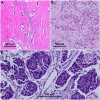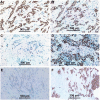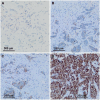Relationship of vitamin D receptor expression with hormone receptors and other clinicopathological features in primary breast carcinomas: A retrospective cross-sectional study
- PMID: 40898467
- PMCID: PMC12401207
- DOI: 10.1097/MD.0000000000044222
Relationship of vitamin D receptor expression with hormone receptors and other clinicopathological features in primary breast carcinomas: A retrospective cross-sectional study
Abstract
Breast cancer is a heterogeneous disease in which estrogen receptor (ER), progesterone receptor (PR), human epidermal growth factor receptor 2 (HER2), and Ki-67 play crucial roles in molecular subtyping, diagnosis, treatment, and prognosis, showing positivity in nearly 90% of cases. The vitamin D receptor (VDR) has been implicated in the oncogenesis and prognosis of various tumors, but its relationship with molecular subtyping factors in breast carcinomas remains to be clarified. This retrospective cross-sectional study included 111 patients who underwent surgery for breast carcinoma. Clinicopathological data were retrospectively analyzed in relation to VDR expression. Histological grade, hormone receptor (HR) status, Ki-67 proliferation index, and other clinicopathological parameters were recorded and their associations with VDR expression were statistically evaluated. Histological grading showed grade 1 in 3.7%, grade 2 in 41.4%, and grade 3 in 54.9% of cases. HR positivity was found in 60.3% of patients, while 39.7% were HR-negative. Ki-67 expression was ≥20% in 65.7% and <20% in 34.3% of cases. VDR expression was low in 54%, moderate in 26.1%, and high in 19.9% of patients. A strong correlation (P < .001) was observed between VDR expression and ER, PR, HR, and Ki-67, while a significant association (P = .025) was found with necrosis and mortality. Additionally, no significant correlation with histological grade (P = .056) was noted. The findings suggest a strong association between VDR and ER, PR status, and the Ki-67 proliferation index in breast carcinoma. Further studies are needed to explore the diagnostic, prognostic, and therapeutic implications of VDR in breast cancer.
Keywords: VDR; breast carcinoma; molecular subtyping.
Copyright © 2025 the Author(s). Published by Wolters Kluwer Health, Inc.
Conflict of interest statement
The authors have no funding and conflicts of interest to disclose.
Figures




Similar articles
-
Sonographic Correlations With Histological Grade and Biomarker Profiles in Breast Invasive Ductal Carcinoma.Cancer Rep (Hoboken). 2025 Aug;8(8):e70288. doi: 10.1002/cnr2.70288. Cancer Rep (Hoboken). 2025. PMID: 40744681 Free PMC article.
-
The Association between ER, PR, HER2, and ER-/PR+ Expression and Lung Cancer Subsequent in Breast Cancer Patients: A Retrospective Cohort Study Based on SEER Database.Breast J. 2023 Nov 11;2023:7028189. doi: 10.1155/2023/7028189. eCollection 2023. Breast J. 2023. PMID: 38021219 Free PMC article.
-
[Comparison of clinicopathological and MRI imaging features between ductal carcinoma in situ with microinfiltration and ductal carcinoma in situ of the breast].Zhonghua Zhong Liu Za Zhi. 2025 Aug 23;47(8):726-733. doi: 10.3760/cma.j.cn112152-20231007-00168. Zhonghua Zhong Liu Za Zhi. 2025. PMID: 40813116 Chinese.
-
Cost-effectiveness of using prognostic information to select women with breast cancer for adjuvant systemic therapy.Health Technol Assess. 2006 Sep;10(34):iii-iv, ix-xi, 1-204. doi: 10.3310/hta10340. Health Technol Assess. 2006. PMID: 16959170
-
Receptor-defined subtypes of breast cancer in indigenous populations in Africa: a systematic review and meta-analysis.PLoS Med. 2014 Sep 9;11(9):e1001720. doi: 10.1371/journal.pmed.1001720. eCollection 2014 Sep. PLoS Med. 2014. PMID: 25202974 Free PMC article.
References
-
- Vanhevel J, Verlinden L, Doms S, Wildiers H, Verstuyf A. The role of vitamin D in breast cancer risk and progression. Endocr Relat Cancer. 2022;29:R33–55. - PubMed
-
- Ercisli MF, Kahrizi D, Aziziaram Z. Environmental factors affecting the risk of breast cancer and the modulating role of vitamin D on this malignancy. Cent Asian J Environ Sci Technol Innov. 2021;2:175–83.
-
- Wanda DSA, Sandhika W, Ridholia R. VDR and WNT/β-catenin expression in invasive breast carcinoma of no special type: role and prognostic value. Pharmacogn J. 2024;16:1349–54.
Publication types
MeSH terms
Substances
LinkOut - more resources
Full Text Sources
Medical
Research Materials
Miscellaneous

